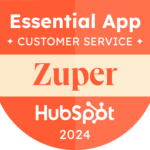Customer Experience (CX) has long been the buzzword globally, due to being identified as a key opportunity for growth in any business. Research proves that customers no longer primarily base loyalty on price or product, instead they stay loyal to companies because of the experience they have with them. Gartner predicts that this year, more than 50% of businesses will redirect their investments to customer experience innovations.
The question for many business leaders however remains – where do we start with an effective customer experience implementation roll-out process?
To find out more, we had a conversation with Lynn Baker, a self-confessed customer experience fanatic and owner of CX Connexion, a consultancy that advises on customer experience. Lynn has spent the last few years immersing herself in identifying the factors of cx that increase sales, reduce customer churn and drive brand loyalty. Her fascination with the concept has taken her around the world, from Disney to Dubai, doing CX Masterclasses, attending CX Summits and spending hundreds of hours studying with the CX University to obtain her Customer Experience Specialist Certification (CXS).
In 2018, Lynn was invited to Judge at the inaugural International Customer Experience Awards held in Amsterdam, where she had the privilege of Judging presentations on CX Strategy design from some of the most successful businesses in the world. In January 2019, Lynn was again a Judge at the Gulf Customer Experience Awards in Dubai, where she judged in the ‘Employee Experience’ and ‘CX Retail’ categories.
Through her own consulting experience, Baker has learned that all clients want is to understand how to implement a customer experience process in a simple, understandable and measurable way. “For a long time, the pieces of the ‘how to’ of a customer experience process eluded her, as it does with many executives attempting to navigate this field. It wasn’t until I was asked by a client “please explain to me in simple terms, how I roll-out a CX Strategy in my business’ that it finally became clear. “I remember thinking at the time, that my client didn’t want to be overwhelmed with the complex and confusing jargon that typically surrounds a customer experience conversation. All my client wanted was a simple explanation of where to start with the process of a customer experience strategy and how to drive it through his organisation effectively.” she said.
This epiphany has been the greatest learning she has taken from her travels around the world. Every leader knows that they must change their business to being customer focused, they are just now sure ‘how to’. “I have therefore spent some time consolidating everything I have learned about CX into a simple customer experience roll-out process that every business can follow. Although some seasoned CX professionals may not like that I have simplified the concept to this degree, this is for those executives who just want to get an understanding of the concept; of where to start and how to implement a customer first culture in their organisation,” she said.
Baker offers a few key points to consider in this process.
The 7-Stage Customer Experience Strategic Roll-out for the uninitiated
 An exceptional customer experience cannot be delivered without equally as much focus on improving the employee experience. The two are integral for the success of any CX strategic implementation to succeed. Therefore, each stage of this CX strategy must be designed with two key focus areas in mind; the employee experience and how that supports the customer experience.
An exceptional customer experience cannot be delivered without equally as much focus on improving the employee experience. The two are integral for the success of any CX strategic implementation to succeed. Therefore, each stage of this CX strategy must be designed with two key focus areas in mind; the employee experience and how that supports the customer experience.
STEP # 1 – DECIDE: EXECUTIVE & EMPLOYEE BUY-IN & COMMITMENT
Introducing a customer focused strategy requires an overhaul of all the policies, procedures and processes throughout an organisation, it is therefore imperative that every person in the company is onboard with the changes that will need to be made.
STEP 2 – DISCOVER: SITUATIONAL ANALYSIS – WHERE ARE WE NOW?
If we don’t know where we are now, we won’t get to where we want to be in the future! Do an analysis of the current customer experience by gathering all the information and customer feedback data you can, to clearly identify how the current customer journey looks, feels and is perceived by the customer. The same is true for the employee experience.
STEP 3 DEFINE: GAP ANALYSIS – WHERE ARE THE OPPORTUNITIES FOR IMPROVEMENT?
Having gathered information and data on the current experience, take time to identify gaps that provide opportunities for improvement. This stage can often be overwhelming, so as a starting point, make a list of all the current pain points and challenges, knowing that they will all be addressed in time, but initially only identify three quick fixes that can be implemented immediately.
STEP 4 – DEVELOP: IDEAL EXPERIENCE DESIGN – WHAT DO WE WANT TO DELIVER IN THE FUTURE.
Once you’ve addressed the key pain points of the current customer journey, take time out to ideate what the ideal customer experience should look like in the future. Begin with the end in mind! Consider how your business, products or services could add more value to your customer in the future and map out what the ideal customer experience should look like in future.
STEP 5 – DESIGN: CHANGE MANAGEMENT PROCESS – HOW ARE WE GOING TO GET THERE?
Change is never easy, but it can be fun, so make it fun! Cultivating a customer first culture requires that you focus on three key aspects:
- PEOPLE What do employees need to know and learn to deliver the ideal experience?
- PROCESSES How can we improve or simplify processes that support employees to deliver
the ideal experience.
- TECHNOLOGY How does our current technology ‘enable’ employees to deliver the ideal
experience? What technology do we need to design or procure that will deliver a
seamless experience for our customers?
STEP 6 – DELIVER: LAUNCH A CX CAMPAIGN – HOW DO WE SUPPORT THE CX INITIATIVE
Like any objective, what isn’t documented, doesn’t get done! Design and deliver an internal communications campaign for the whole business, that continuously reinforces the company’s commitment to delivering on its brand promises.
STEP 5 – DEEP DIVE DATA & DELIVERABLES: HOW DID WE DO, WHERE TO FROM HERE?
This process to date would have taken a few months, but it will all be in vain if management do not deep dive the data to establish if deliverables have been met. In fact, deep diving customer and employee feedback should be a KPI for select individuals, who are tasked with continuously monitoring customer and employee feedback and create a closed loop system to pain points.
If you follow this process, you will be well on your way to creating what is commonly referred to as an ‘inside-out’ company, one that focuses on customer and employee needs and builds an agile business that is committed to delivering an exceptional customer experience.
For more information contact: Lynn Baker on lynn@cxconnexion.com or visit https://www.cxconnexion.co.za
- Top 50 DSTV TV programmes – October 2024 - 12th November 2024
- Top 50 FTA TV programmes – October 2024 - 12th November 2024
- The Latest MAPS™ Data: A Comprehensive Look at Consumer Behaviour - 12th November 2024





